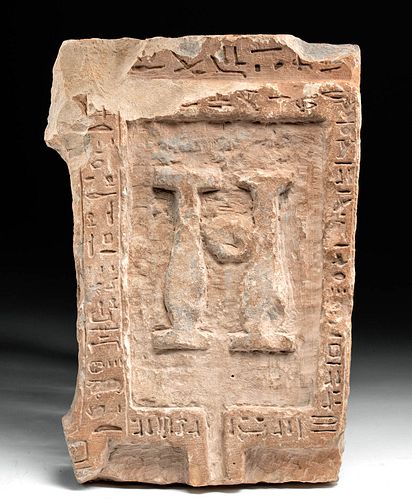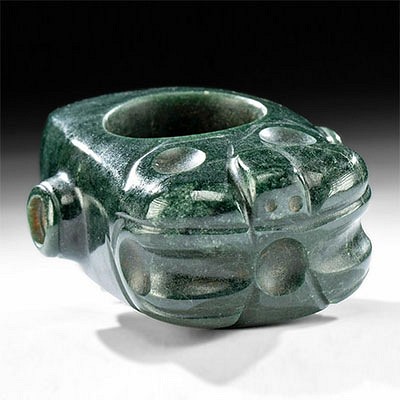Translated Egyptian Limestone Offering for Pa-Wab
Lot 1
About Seller
Artemis Fine Arts
686 S Taylor Ave, Ste 106
Louisville, CO 80027
United States
Selling antiquities, ancient and ethnographic art online since 1993, Artemis Gallery specializes in Classical Antiquities (Egyptian, Greek, Roman, Near Eastern), Asian, Pre-Columbian, African / Tribal / Oceanographic art. Our extensive inventory includes pottery, stone, metal, wood, glass and textil...Read more
Categories
Estimate:
$6,000 - $8,000
Absentee vs Live bid
Two ways to bid:
- Leave a max absentee bid and the platform will bid on your behalf up to your maximum bid during the live auction.
- Bid live during the auction and your bids will be submitted real-time to the auctioneer.
Bid Increments
| Price | Bid Increment |
|---|---|
| $0 | $25 |
| $300 | $50 |
| $1,000 | $100 |
| $2,000 | $250 |
| $5,000 | $500 |
| $10,000 | $1,000 |
| $20,000 | $2,500 |
| $50,000 | $5,000 |
| $100,000 | $10,000 |
| $200,000 | $20,000 |
About Auction
By Artemis Fine Arts
Sep 10, 2020
Set Reminder
2020-09-10 10:00:00
2020-09-10 10:00:00
America/New_York
Bidsquare
Bidsquare : Antiquities | Asian | Ethnographic Art
https://www.bidsquare.com/auctions/artemis-gallery/antiquities-asian-ethnographic-art-5546
Featuring classical antiquities, ancient and ethnographic art from cultures encompassing the globe. Egyptian, Greek, Roman, Etruscan, Near Eastern, Asian, Pre-Columbian, Native American, African / Tribal, Oceanic, Spanish Colonial, Russian, Fossils, Fine Art, more! Artemis Fine Arts info@artemisfinearts.com
Featuring classical antiquities, ancient and ethnographic art from cultures encompassing the globe. Egyptian, Greek, Roman, Etruscan, Near Eastern, Asian, Pre-Columbian, Native American, African / Tribal, Oceanic, Spanish Colonial, Russian, Fossils, Fine Art, more! Artemis Fine Arts info@artemisfinearts.com
- Lot Description
Egypt, Late Dynastic Period, 26th to 31st Dynasty, ca. 664 to 332 BCE. A rectangular funerary offering table with a central relief, hand-carved from a large slab of limestone. The body features a pair of low relief hes-vases with inverted piriform bodies and projecting discoid rims, and a central orb is perhaps indicative of an offering bowl. A narrow channel is carved at the top of the perimeter. The perimeter and lower body are presented with a lengthy hieroglyphic inscription that when translated reads, "God's father, prophet, Hem-Ka priest…prophet of…, prophet Montu?, god's father, prophet of…, Isis the great, prophet of Re-Horakhty…Min-Horus…, lady of the town of Tep-Ihu, giving bread, beer, oxen, fowl, wine, milk and every good and pure thing…Overseer of prophets, Pa-Wab." Hes-vases were used in purification, libation, and offering rituals - the hes-vase hieroglyph translates as "praise" or "to favor" - and their likeness in this example suggests this table was used for offerings of precious oils or other liquids. Size: 10.25" W x 14.75" H (26 cm x 37.5 cm)
For an example of a hes-vase with a strikingly similar profile as those in the central relief, please see The Metropolitan Museum of Art, accession number 35.3.24.
A stylistically similar example of an offering table, of a slightly larger form and from the Middle Kingdom period, hammered for $50,000 at Christie's, New York "Antiquities" auction (sale 2007, June 4, 2008, lot 3).
Provenance: private J.H. collection, Beaverton, Oregon, USA; ex-Explorer Ancient Art, New York, USA; ex-Royal-Athena Gallery, New York, USA and London, UK; ex-private UN diplomat P.A. collection, purchased in Egypt in the 1970s
All items legal to buy/sell under U.S. Statute covering cultural patrimony Code 2600, CHAPTER 14, and are guaranteed to be as described or your money back.
A Certificate of Authenticity will accompany all winning bids.
We ship worldwide and handle all shipping in-house for your convenience.
#149648Professionally repaired from roughly twelve pieces, with resurfacing along obverse break lines, and chipping and light adhesive residue to those on verso. Losses to areas of periphery, perimeter, hes-vases, and verso as shown. Nicks and fading to some raised details and inscribed hieroglyphs, with light encrustations. Nice earthen deposits throughout, and many hieroglyphs still legible.Condition
- Shipping Info
-
All shipping is handled in-house for your convenience. Your invoice from Artemis Gallery will include shipping calculation instructions. If in doubt, please inquire BEFORE bidding for estimated shipping costs for individual items.
-
- Buyer's Premium



 EUR
EUR CAD
CAD AUD
AUD GBP
GBP MXN
MXN HKD
HKD CNY
CNY MYR
MYR SEK
SEK SGD
SGD CHF
CHF THB
THB














